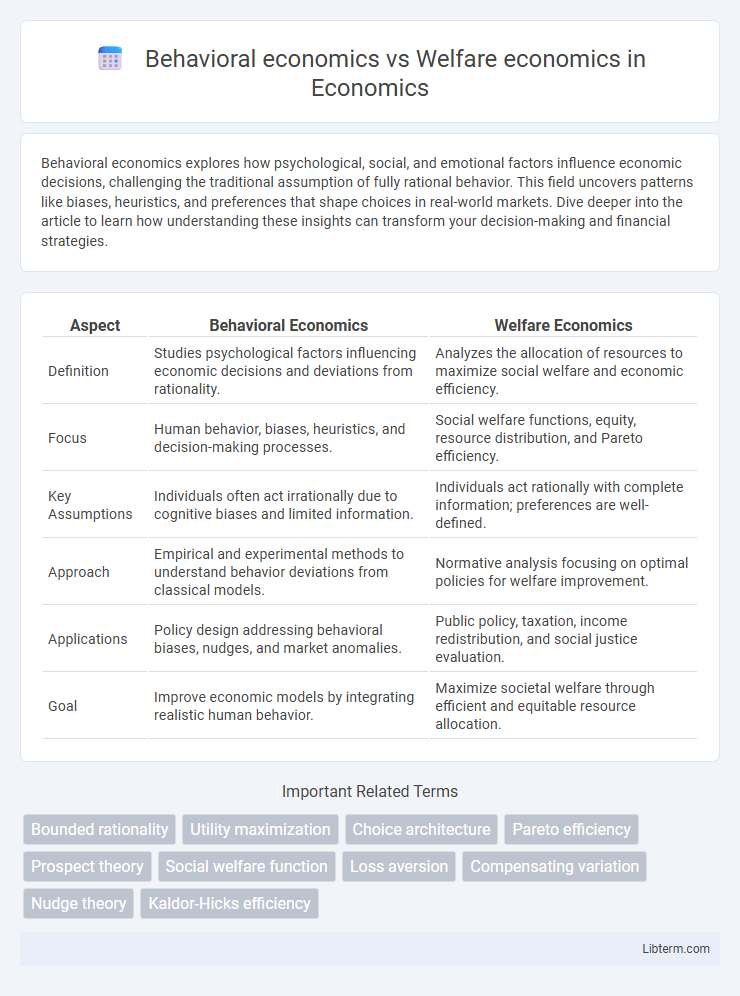Behavioral economics explores how psychological, social, and emotional factors influence economic decisions, challenging the traditional assumption of fully rational behavior. This field uncovers patterns like biases, heuristics, and preferences that shape choices in real-world markets. Dive deeper into the article to learn how understanding these insights can transform your decision-making and financial strategies.
Table of Comparison
| Aspect | Behavioral Economics | Welfare Economics |
|---|---|---|
| Definition | Studies psychological factors influencing economic decisions and deviations from rationality. | Analyzes the allocation of resources to maximize social welfare and economic efficiency. |
| Focus | Human behavior, biases, heuristics, and decision-making processes. | Social welfare functions, equity, resource distribution, and Pareto efficiency. |
| Key Assumptions | Individuals often act irrationally due to cognitive biases and limited information. | Individuals act rationally with complete information; preferences are well-defined. |
| Approach | Empirical and experimental methods to understand behavior deviations from classical models. | Normative analysis focusing on optimal policies for welfare improvement. |
| Applications | Policy design addressing behavioral biases, nudges, and market anomalies. | Public policy, taxation, income redistribution, and social justice evaluation. |
| Goal | Improve economic models by integrating realistic human behavior. | Maximize societal welfare through efficient and equitable resource allocation. |
Introduction to Behavioral and Welfare Economics
Behavioral economics explores how psychological factors and cognitive biases influence individual decision-making, contrasting traditional economic models that assume rational behavior. Welfare economics studies how resources can be allocated to maximize social welfare, emphasizing efficiency and equity in policy outcomes. Both fields intersect by addressing human behavior's impact on economic welfare and designing interventions to improve societal well-being.
Defining Behavioral Economics
Behavioral economics studies how psychological factors and cognitive biases influence economic decision-making, diverging from traditional economic theories that assume rational behavior. It integrates insights from psychology into economic models to explain anomalies such as bounded rationality, loss aversion, and heuristics affecting individual choices. This field contrasts with welfare economics, which focuses on the allocation of resources to maximize social welfare based on normative criteria and assumes rational actors.
Fundamentals of Welfare Economics
Welfare economics studies how resource allocation affects social welfare, emphasizing Pareto efficiency and social welfare functions to evaluate economic policies. It assumes rational agents and perfect information, aiming to maximize overall well-being and equity in society. Behavioral economics challenges these assumptions by incorporating psychological insights into decision-making, highlighting how biases and heuristics impact individual choices and market outcomes.
Historical Evolution of Both Fields
Behavioral economics evolved from traditional economic theories during the late 20th century, integrating insights from psychology to better understand irrational decision-making and cognitive biases influencing economic behavior. Welfare economics, rooted in the 19th and early 20th centuries, focuses on the allocation of resources and well-being, with foundational contributions from economists like Arthur Pigou and Vilfredo Pareto who developed criteria for social welfare optimization. Historical development of these fields reflects a shift from normative assessments of economic efficiency in welfare economics to empirical observations and experimental methods in behavioral economics, broadening the scope of economic analysis.
Key Theoretical Differences
Behavioral economics integrates psychological insights into economic decision-making, challenging the traditional assumption of fully rational agents by emphasizing cognitive biases, heuristics, and emotions in shaping choices. Welfare economics primarily focuses on evaluating economic policies and outcomes to maximize social welfare based on normative criteria, assuming rational behavior and efficient resource allocation. The key theoretical difference lies in behavioral economics addressing real-world decision-making imperfections, while welfare economics centers on normative assessments of economic efficiency and equity.
Role of Rationality in Each Discipline
Behavioral economics challenges the traditional assumption of perfect rationality by incorporating psychological insights into economic decision-making, highlighting anomalies such as biases and bounded rationality. Welfare economics, grounded in normative analysis, assumes rational agents to evaluate and design policies that maximize social welfare and economic efficiency. The role of rationality in welfare economics typically serves as a benchmark for optimal outcomes, whereas behavioral economics emphasizes realistic, imperfect human behavior in shaping economic models and interventions.
Policy Implications and Applications
Behavioral economics influences policy by integrating psychological insights into decision-making processes, leading to interventions like nudges that improve individual welfare without restricting freedom of choice. Welfare economics emphasizes optimal resource allocation and equity, guiding policies that aim to maximize social welfare through redistribution and market corrections. Policymakers apply behavioral economics to design more effective programs addressing biases and heuristics, while welfare economics informs taxation, public goods provision, and cost-benefit analyses to achieve economic efficiency and fairness.
Critiques and Limitations
Behavioral economics is critiqued for its reliance on experimental data that may lack external validity and sometimes overlooks aggregate welfare impacts. Welfare economics faces limitations in addressing real-world decision-making complexities, as it often assumes rational behavior and complete information. Both fields struggle with integrating normative judgments, where behavioral insights challenge traditional welfare criteria, yet practical policy applications remain contentious.
Integration and Overlap between Fields
Behavioral economics and welfare economics intersect through their shared goal of improving individual well-being and policy outcomes by incorporating real-world decision-making processes. Behavioral economics enhances welfare economics by providing empirical insights into human biases and heuristics, which helps design better-targeted interventions and social policies. The integration of these fields enables more accurate assessments of utility, welfare loss, and policy effectiveness by accounting for actual behavioral responses rather than idealized rational models.
Future Directions in Economic Research
Future directions in economic research emphasize integrating behavioral economics' insights on human psychology and decision-making biases with welfare economics' normative frameworks to enhance policy design and effectiveness. Advances in experimental and field studies are expanding understanding of how actual behavior deviates from traditional rational choice models, informing more accurate welfare assessments in diverse economic contexts. Emerging interdisciplinary approaches leveraging big data and machine learning aim to refine the measurement of individual well-being and improve social welfare evaluation under behavioral assumptions.
Behavioral economics Infographic

 libterm.com
libterm.com